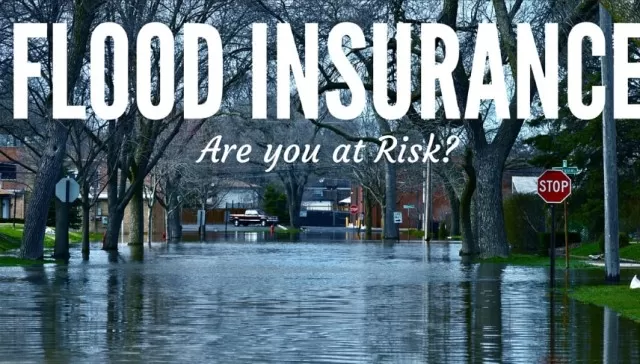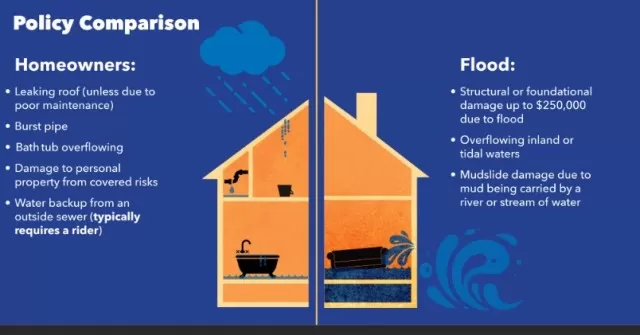Flood Insurance Insights: Lesser-Known Facts.In the intricate web of home insurance, assumptions can often lead to unexpected revelations. While your homeowner’s insurance policy may provide a comforting shield against various perils, it’s essential to recognize a glaring omission: floods. The sobering truth is that standard homeowner’s policies do not extend their protective embrace to the capricious wrath of flooding, leaving a potential vulnerability that demands your attention.
For those residing in regions characterized by the looming specter of heavy rainfall, the ferocity of hurricanes, or the tempestuous dance of tropical storms, the necessity for flood insurance becomes paramount. This additional layer of coverage serves as a crucial safeguard against the ravages of inundation, providing a financial lifeline when the waters rise and the unexpected strikes.
Yet, before embarking on the path toward comprehensive flood insurance, it is prudent to arm yourself with knowledge, understanding the nuanced landscape and intricacies that underpin this vital form of protection. The realm of flood insurance is a realm of preparation and foresight—a realm where the echoes of vulnerability can be silenced through the fortification of informed choices. As you embark on this journey, let the pillars of knowledge and understanding be your guiding beacons. By arming yourself with these essential insights, you elevate your capacity to safeguard your haven from the capricious whims of floods, ensuring that your dwelling remains a sanctuary of tranquility, even in the face of nature’s tempestuous embrace.
Who is in Need of It?

Mandatory Flood Insurance: A Necessity for Residents and Property Owners in High-Risk Zones.
Residing in regions prone to flooding can come with a set of financial responsibilities that extend beyond the usual concerns of homeowners and landlords.
Those who own properties nestled within high-risk flood zones often find themselves faced with a crucial requirement: owning flood insurance. This mandate particularly affects individuals seeking to secure a mortgage for a property located in such vulnerable zones, as they are obligated to maintain flood insurance throughout the entire duration of the loan.
However, for those fortunate enough to own property outside the boundaries of flood-prone areas, the decision to purchase flood insurance remains discretionary rather than compulsory.
While homeownership and property management come with their share of responsibilities, the presence of natural hazards like flooding adds an additional layer of complexity.
Those who find themselves residing or investing in regions recognized as high-risk flood zones are confronted with an imperative choice: complying with the demand for flood insurance. This obligation takes on even more significance when purchasing a property through a mortgage arrangement, as the loan agreement stipulates continuous coverage against flood-related damages.
This not only safeguards the financial interests of lenders but also provides a safety net for property owners against the unpredictable forces of nature.
On the contrary, for those whose properties are positioned beyond the geographic bounds of flood-prone zones, the necessity of flood insurance takes on a different aspect.
While not mandated by regulations, the decision to obtain such coverage becomes an exercise in risk management and prudent financial planning. The absence of a legal requirement should not overshadow the potential benefits that flood insurance offers to property owners, offering a buffer against unexpected and potentially devastating losses caused by flooding events.
In conclusion, the need for flood insurance is intricately tied to the geographical location of properties and the inherent risks posed by flood-prone zones.
Whether an obligatory aspect imposed by mortgage agreements or a discretionary choice made in the interest of long-term security, the importance of flood insurance cannot be undermined. It stands as a safeguard against the capricious nature of floods, offering homeowners and landlords the means to navigate uncertain waters with a greater sense of financial stability.
Mandatory Mortgage Prerequisites in Flood-Prone Areas
The journey towards property ownership takes an additional turn when the sought-after property lies within the realm of flood-prone terrain.
In such instances, prospective buyers are presented with a distinct set of obligations, specifically pertaining to flood insurance, that must be fulfilled prior to the closure of a loan agreement. This crucial step not only safeguards the interests of the borrowers but also aligns with federal regulations that govern the relationship between lenders and mortgage holders in high-risk flood zones.
When embarking on the path of acquiring a loan for a property nestled within a flood zone, the prospective borrower is met with a vital stipulation: the provision of irrefutable evidence of flood insurance coverage.
This prerequisite stands as a testament to the comprehensive approach taken by lending institutions, aiming to mitigate potential risks stemming from natural calamities. By necessitating proof of flood insurance prior to the loan’s finalization, lenders bolster their confidence in the borrower’s ability to safeguard the investment from the unforeseen impact of flooding events.
Moreover, the responsibility extends beyond the individual borrower.
Federal law mandates that lenders assume a proactive role in ensuring the protection of mortgage holders who possess properties within flood-prone areas. This legally mandated vigilance encompasses a dual objective: first, to ascertain that borrowers secure the requisite flood insurance coverage, and second, to continually monitor and enforce the maintenance of this coverage throughout the loan’s lifespan.
This harmonious interplay between borrowers and lenders underlines the collective commitment to fortify financial stability in the face of potential flood-related losses.
In conclusion, the realm of mortgage requirements takes on a distinctive hue when transacting in flood-prone territories.
The obligation to furnish evidence of flood insurance coverage underscores the dedication to preemptive risk mitigation, benefitting both borrowers and lenders alike. As federal regulations mandate a symbiotic responsibility between mortgage providers and holders, the protective umbrella of flood insurance extends its reach, safeguarding property investments against the turbulent currents of unforeseen flooding events.
Where to Secure Your Coverage

When it comes to acquiring essential flood insurance coverage, a range of options awaits, ensuring that property owners can make informed decisions tailored to their specific needs.
The National Flood Insurance Program (NFIP) website serves as a comprehensive hub, showcasing an extensive roster of over 80 esteemed private insurance companies ready to provide the necessary protection against flood-related risks. This wealth of choices empowers individuals to select an insurance provider that resonates with their preferences and requirements.
For those seeking a personalized touch and expert guidance, the avenue of property insurance agents presents a convenient and accessible pathway.
These professionals possess the expertise to navigate the intricate landscape of flood insurance, offering tailored advice that aligns with the unique characteristics of the property and the preferences of the owner. By leveraging the insights of property insurance agents, individuals can secure a policy that not only meets legal requirements but also provides a customized shield against the potential financial repercussions of flooding incidents.
The process of obtaining flood insurance is thus marked by versatility and accessibility, ensuring that property owners are equipped with the tools to make informed choices.
Whether opting for the breadth of options presented by the NFIP website or seeking the personalized expertise of property insurance agents, the journey towards comprehensive flood insurance coverage is characterized by empowerment and proactive risk management.
Understanding Flood Insurance Costs
The expense associated with flood insurance is a nuanced interplay of diverse factors, where the type of coverage you seek and the specific characteristics of your dwelling intertwine to determine the premium you’ll pay.
The age, architectural style, and geographic placement of your home become pivotal elements that collectively shape the likelihood of your property being impacted by adverse weather conditions, thereby intricately influencing the rate of your insurance coverage.
Delving into the specifics, the age of your residence stands as a marker of its susceptibility to potential damage in the face of severe weather events.
The architectural style further contributes to this risk assessment, as certain designs might either mitigate or amplify the effects of flooding, thus modulating the premium calculation accordingly. Equally pivotal is the geographic context in which your home resides—a critical determinant that helps quantify the probability of your property succumbing to the forces of nature.
It’s important to note that flood insurance rates are standardized at a national level, ensuring uniformity across different insurance providers.
This consistency eliminates variations in rates based on the insurance company you choose, underscoring the equitable nature of flood insurance pricing. However, the landscape of flood insurance isn’t devoid of opportunities for savings.
Qualifying for discounts represents a tangible avenue to potentially reduce your premium burden, providing a financial incentive for proactive risk management.
In conclusion, the cost of flood insurance emerges as a multifaceted equation, where elements like coverage type, architectural attributes, and geographic setting converge to define the premium you’ll be required to pay.
While rates remain constant across insurance companies, the potential for discounts presents a promising prospect for those willing to take proactive steps to fortify their property against the vagaries of flooding.
Tailoring Your Protection: Diverse Coverage Choices

Crafting a protective umbrella for your property necessitates a deliberate consideration of various coverage options, each tailored to encapsulate distinct facets of your valuable investment.
The scope of coverage you elect to procure is intricately intertwined with the value of your home and the possessions it shelters, creating a customized shield against the potential financial repercussions of flooding incidents.
One avenue available to homeowners is the acquisition of a building policy—an option that extends its safeguarding embrace to the fundamental elements constituting your dwelling.
From the robust walls that shield you from the elements to the protective roof above, and encompassing the very floors you tread upon, a building policy assures comprehensive coverage for the structural core of your home. By securing this form of insurance, you establish a safeguard against the potential damages inflicted by flooding events upon these vital components.
For those seeking a more all-encompassing layer of protection, the option to augment coverage with a contents policy presents itself.
This dynamic add-on extends its coverage to include your household valuables, encompassing possessions that hold both financial and sentimental worth. Whether it’s cherished heirlooms, state-of-the-art electronics, or precious artwork, a contents policy acts as a financial buffer, mitigating the potential losses that could arise from the destructive effects of flooding.
However, it’s important to recognize that both building and contents policies share a common limitation: they do not extend their reach to encompass the land on which your home is situated.
While your dwelling and its internal contents are under the protective umbrella of these policies, the physical terrain upon which your property rests remains beyond their purview.
In essence, the array of coverage options before you is a testament to the comprehensive nature of flood insurance.
The decision to opt for a building policy, a contents policy, or a combination thereof hinges upon a nuanced assessment of your property’s value and the possessions it shelters. By thoughtfully tailoring your coverage, you craft a shield that aligns with your unique needs, offering a sense of financial security in the face of unforeseen flooding events.
*The information is for reference only.